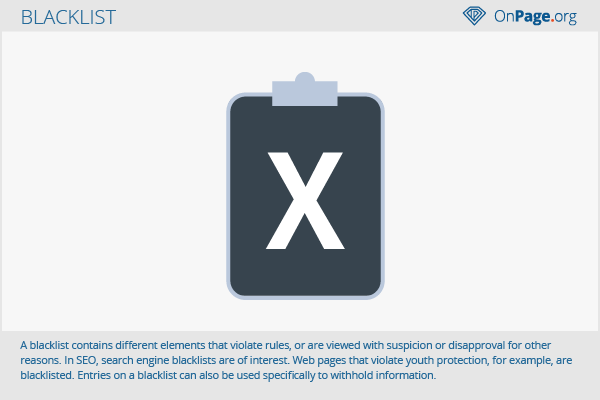Blacklist
A blacklist contains different elements that violate rules, or are viewed with suspicion or disapproval for other reasons. In SEO, search engine blacklists are of interest. Web pages that violate youth protection, for example, are blacklisted. Entries on a blacklist can also be used specifically to withhold information. Countries such as China block certain websites in order to protect their regime. Such a blacklist limits freedom of expression.
Blacklist for websites
Google has its own blacklist of sites and IP addresses. Websites that appear on this list have been involved in severe spamming or violate existing regulations as far as Google is concerned. Such websites are deleted from the search engine database and can therefore no longer be found with the search function. There are also country-specific filters that are applied to all data collected on websites. Thus pages can be added to the blacklist, depending on the country, that violate specific laws with their content, such as the Youth Protection Act.
Inclusion on the blacklist
Google is proactive when it comes to the protection of users. This means that websites are removed from the index as a precaution and alerts on the part of users are not required. The Internet is automatically scanned for suspicious activity. If Google finds malware on a website, visitors will be warned with messages such as “This site may harm your computer.” In some cases, Google notifies the operator via the Google webmaster tools and provides information on the places in the code that were discovered by the system. If the operator does not have a Google account, then Google will attempt to reach them by e-mail, for example, admin@sitename or webmaster@sitename.
Erroneous blacklist entries
Whether your domain is blacklisted or not by Google can be tested through various websites.[1] If you are incorrectly blacklisted, you can submit a re-inclusion request, in other words, a request to Google to once again be listed in the index. The content in question, which caused the removal from the index, must be removed of course.
Criticism of Google’s blacklist
Despite Google’s undoubtedly good intentions to protect Internet users, there is still an aspect which can criticized. The question is whether and why Google can decide which pages to block. Google can adjust the filter and in theory also put competitors and any other websites on the blacklist at their discretion. These will then no longer be locatable on the largest search engine, resulting in great damage. Thus Google has a certain amount of power and it raises the question whether this won’t be abused sooner or later. As long as a website is not a potential harm to users, it must also be freely available.[2]
Other blacklists
Other blacklists exist on the Internet, for example:
- An email blacklist is a common method to reduce email spam. If a mail server IP address is on this list, it must be expected that (some) emails will not be received, which were sent from that address. There are websites where you can check your own server address.[3]
- The blocking of websites to protect a regime is practiced in China, for example. Not only websites with liberal content get blocked, but also sites that are critical of a regime. Thus, freedom of speech is restricted. Some reports mention that it is almost a whitelist, i.e. a list on which only the permitted Websites are listed.[4] The purpose of the Internet to provide anyone freely accessible information would no longer be given.
References
- ↑ Google Blacklist Checker dennisnafisi.com. Accessed on 05/19/2014
- ↑ When did Google become the Internet Police? pcmag.com. Accessed on 05/19/2014
- ↑ blacklist check mxtoolbox.com. Accessed on 05/19/2014
- ↑ China closes down the internet forbes.com. Accessed on 05/19/2014
Web Links

